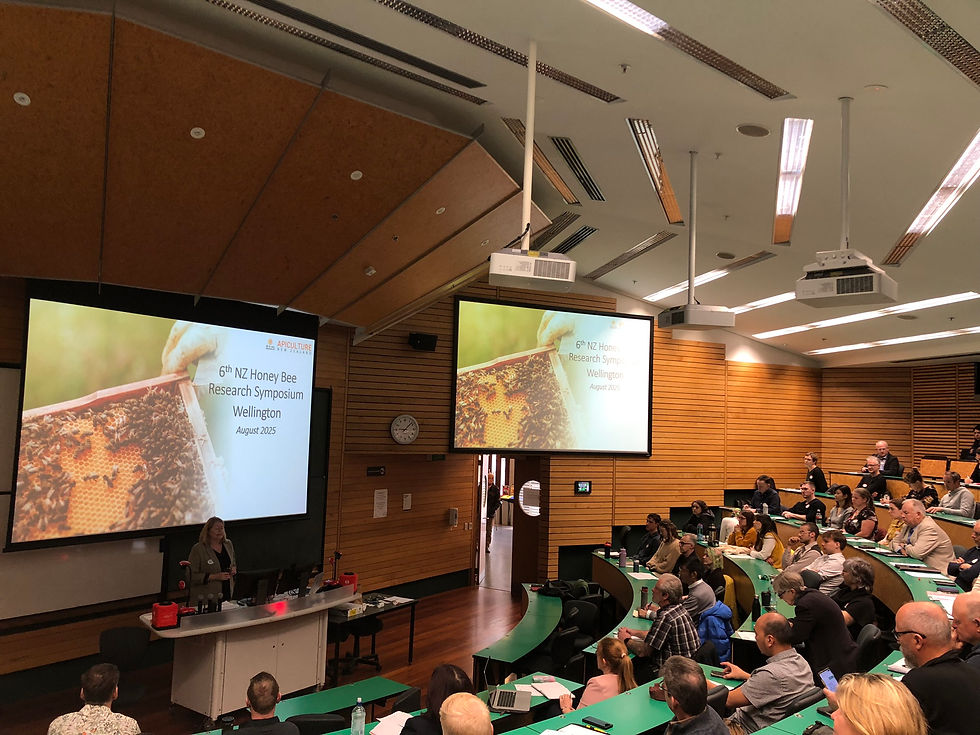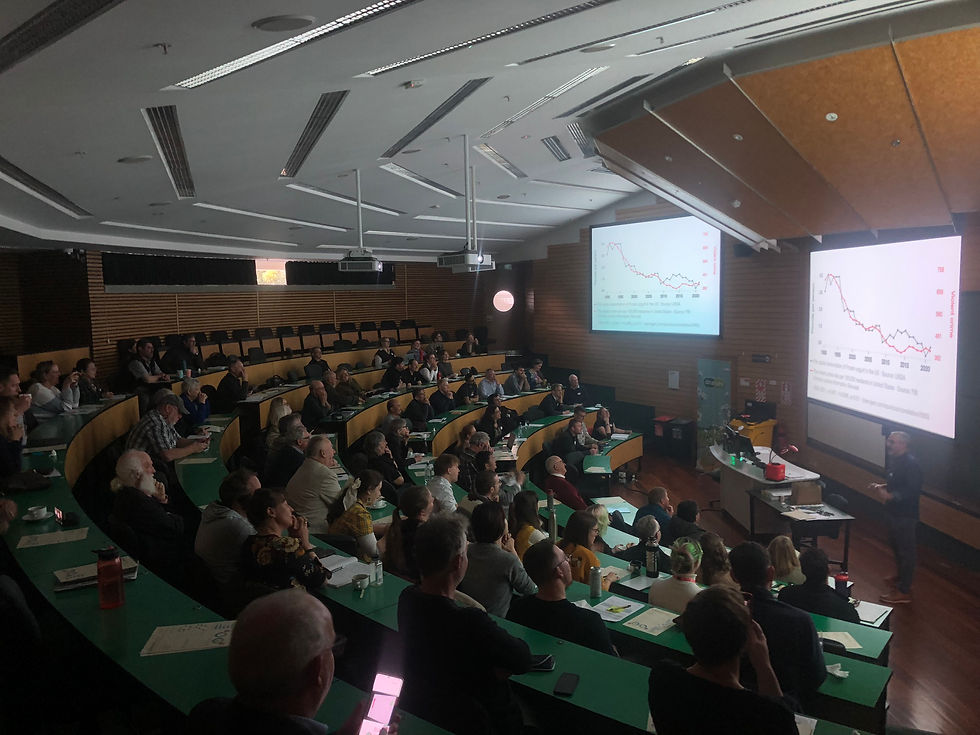Varroa Pains, Bee Brains and Pollen Grains – Takeaways from the 2025 Honey Bee Research Symposium
- Patrick Dawkins

- Sep 2, 2025
- 4 min read
Now an established fixture on the events calendar for the apiculture industry, the 6th New Zealand Honey Bee Research Symposium in Wellington on August 28 not only detailed the latest in research in all things honey bees and related fields, but saw discussion on how to fund ongoing work.
With the industry going through a period of reckoning regarding funding national-level projects, it was perhaps unsurprising that a lecture theatre at Victoria University of Wellington holding some of New Zealand beekeeping’s most dedicated participants and scientists saw healthy discussion with a ‘where-to-from-here’ bent.

Around 100 scientists, beekeepers and related stakeholders heard more than a dozen research updates, while Apiculture New Zealand CEO Karin Kos provided an update on their current industry consultation progress. Later, New Zealand Beekeeping Inc advisor Ian Fletcher challenged the industry to concentrate potential outside-industry funders’ – namely government – attentions on the potential for the honey bee industry to boost productivity over a range of industries through continued and improved pollination. Also offering considerations on the key topic of ‘where the money comes from’ was retired Otago beekeeper Alan McCaw, who extolled the value of industry building up a greater base of money to back research projects.
Here's a few observations from the lecture theatre seats…
The middle of the day saw three students from the host university update on their research with dsRNA-interference (gene silencing) technologies to control varroa. Much of the previous work from the lab using the technique has been to aid development of ‘Vadescana’, a product developed by American company Greenlight Bioscience which has gained preliminary approval in the US and may soon be retailed as Norroa™ – for a whopping $22USD per treatment. That pricing news took some wind out of beekeepers in the room, but the Victoria Uni scientists are forging on with their own work into better understanding how gene-silencing prevents varroa reproduction. Projects are focusing on seeking new target sites for RNA-interference, tracking RNA-i through varroa with “fluro-labelling”, and assessing varroa movements post-treatment.
An always well received update is that out of Canterbury University Associate Professor Heather Hendrickson’s lab as they seek to develope an American foulbrood “prophylactic” treatment or “vaccine” using phage-therapy. “We are still doing work behind the scenes to create the perfect phage cocktail,” Dr Hendrickson reported. Field trials in association with Plant and Food Research (P&FR) will begin in the near future to determine the “stability” of their phage cocktail, but Hendrickson was optimistic. “We think we can produce a very effective AFB control for New Zealand beekeepers”.
How can chicken eggs be used to save honey bees? Victoria University PhD student Neil MacMillan is undergoing a project using poultry eggs to attempt to incubate anti-varroa antibodies. Future work will determine the varroa-killing ability of such antibodies, but, regardless, his research drew praise from Dr James Sainsbury of P&FR who commented “it is inspiring to see this level of immunology applied to bees”.

Pike Stahlmann-Brown, principal scientists at Manaaki Whenua – Landcare Research, presents results from the 2024 Colony Loss Survey. An enlightening report came from leading palynologist Dr Katherine Holt of Massey University who, funded by Te Pitau Ltd, has been researching the pollen contents of 50 New Zealand and 32 Australian “manuka” retail honey samples. She found that frequently in the Australian honeys eucalyptus pollens were the dominant variety, whereas in New Zealand samples mānuka pollens were almost always the dominant or secondary pollen. Holt determined it is “easy” to use pollen to differentiate which side of the Tasman honey has been source. “It is going to become increasingly important to differentiate, in cases of adulteration,” she pointed out.
While cleaning out an office at their Ruakura facility, P&FR scientists discovered a file dedicated to a 1947-53 honey bee breeding trial using artificial insemination of queen bees. Dr Ashley Mortensen reported some of the most interesting observations as she looked back nearly 80 years on details of beekeepers from all over the country contributing breeder queens to the project. The average age of queens submitted was just under one year, but one three-and-a-half-year-old proven-performer was sent, and five others nearly two years old. Seven beekeepers provided honey yield data, with 110lbs (50kg) the average and all stating clover as the primary nectar source.
Allen McCaw’s presentation on building up a funding base for future research stressed the need for industry participants to contribute, and potentially allow large portions of their contributions to go towards establishing an “investment base” in initial years, which could provide big benefits later. “The industry needs to stand up and take care of some of its own issues”, he stated, pointing out a commodity levy with a portion of funds specifically earmarked for R&D would be ideal. “Wishes are free, but they can come to bee”, McCaw closed with.








Comments